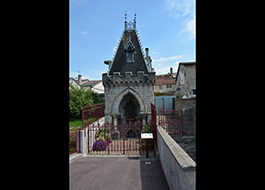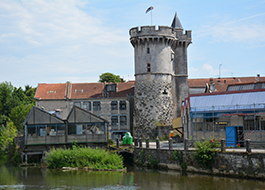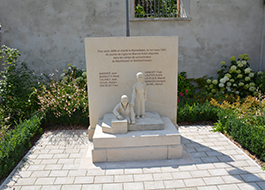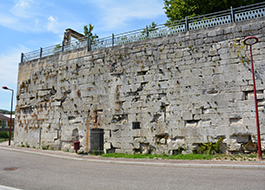Ligny-en-Barrois
Durée visite : 170 minutes
Moyen : Pédestre
En 1155 , Ligny-en-Barrois passe par mariage des comtes de Champagne aux comtes de Bar. De 1231à 1719, toujours à la suite d’un mariage, le village échoit à la famille des Luxembourg. Ceux-ci se heurtent aux comtes de Bar, et recherchent tour à tour l’alliance germanique ou française. Charles V érige Ligny en comté en 1369. Allié cette fois des Bourguignons, c’est Jean de Luxembourg-Ligny qui vend Jeanne d’Arc aux Anglais. Puis en 1544, Ligny est ravagé par l’armée de Charles Quint. Achetée en 1719 par la Lorraine, la cité devient française en 1766. Le XIXe siècle se caractérise par le dynamisme industriel. Ligny abrite aujourd’hui Essilor et Evobus. La cité est par ailleurs la patrie du père de Brigitte Bardot.
In 1155, Ligny-en-Barrois went through the marriage of the Counts of Champagne to the Counts of Bar. From 1231 to 1719, still following a marriage, the village fell to the Luxembourg family. These clash with the counts of Bar, and seek in turn the Germanic or French alliance. Charles V sets up Ligny as a county in 1369. This time ally of the Burgundians, it is Jean de Luxembourg-Ligny who sells Joan of Arc to the English. Then in 1544, Ligny was ravaged by the army of Charles Quint. Purchased in 1719 by Lorraine, the city became French in 1766. The 19th century is characterized by industrial dynamism. Ligny is now home to Essilor and Evobus. The city is also the homeland of Brigitte Bardot’s father.
Im Jahr 1155 ging Ligny-en-Barrois durch die Hochzeit der Grafen von Champagne mit den Grafen von Bar. Von 1231 bis 1719, noch nach einer Heirat, fiel das Dorf an die luxemburgische Familie. Diese kollidieren mit den Grafen von Bar und suchen wiederum das germanische oder französische Bündnis. Karl V. gründet Ligny 1369 als Grafschaft. Diesmal ist es Jean de Luxembourg-Ligny, der Jeanne d’Arc an die Engländer verkauft. Dann wurde Ligny 1544 von der Armee von Charles Quint verwüstet. 1719 von Lothringen gekauft, wurde die Stadt 1766 französisch. Das 19. Jahrhundert ist geprägt von industrieller Dynamik. In Ligny leben jetzt Essilor und Evobus. Die Stadt ist auch die Heimat von Brigitte Bardots Vater.

D’azur à trois croissants d’argent entrelacés en chef et trois chardons d’or en pointe feuillés et tigés de même.
Devise
Azure with three crescents Argent interwoven in chief and three thistles in a point with leaves and stems in the same way.
Motto
- In my sorrows I will increase.
- These are talking weapons (see motto).
- The official status of the coat of arms remains to be determined.
Azurblau mit drei Halbmonden, die Argent in der Spitze und drei Disteln in einer Spitze mit Blättern und Stielen auf die gleiche Weise verwoben hat.
Motto
- In meinen Sorgen werde ich zunehmen.
- Das sind sprechende Waffen (siehe Motto).
- Der offizielle Status des Wappens muss noch festgelegt werden.

Les habitants de Ligny-en-Barrois s’appellent les Linéens et les Linéennes.
The inhabitants of Ligny-en-Barrois are called the Linéens and the Linéennes.
Die Einwohner von Ligny-en-Barrois heißen Linéens und Linéennes.
Les points de visites
.
Au XVIIIe siècle, les ducs de Lorraine entreprennent d’importants travaux d’urbanisme. La Porte de France ou Porte Dauphine est achevée en 1780. Avec celles de Strasbourg et de Givrauval, elle est construite à l’emplacement d’une ancienne porte médiévale. Ces monuments se composent d’une ouverture centrale, et de deux passages voûtés de part et d’autre pour les piétons.
In the 18th century, the Dukes of Lorraine undertook major town planning works. The Porte de France or Porte Dauphine was completed in 1780. Along with those of Strasbourg and Givrauval, it was built on the site of an old medieval door. These monuments consist of a central opening, and two arched passages on either side for pedestrians.
Im 18. Jahrhundert unternahmen die Herzöge von Lothringen große städtebauliche Arbeiten. Die Porte de France oder Porte Dauphine wurde 1780 fertiggestellt. Zusammen mit denen von Straßburg und Givrauval wurde sie an der Stelle einer alten mittelalterlichen Tür errichtet. Diese Denkmäler bestehen aus einer zentralen Öffnung und zwei gewölbten Durchgängen für Fußgänger auf beiden Seiten.
.
.
La première église paroissiale été détruite en 1544 par les Impériaux. L’actuelle a été reconstruite en 1552, dans un style gothique. Des formes Renaissance marquent les deux portails latéraux.L’un est surmonté de la statue de saint Augustin, l’autre de la Vierge à l’Enfant. Les deux chapelles latérales datent du XIXe siècle. Un clocher carré avec tour, ajouté en 1862, abrite une cloche de bronze de 1505. Une peinture sur soie de Notre-Dame des Vertus est présente dans la chapelle homonyme. Oeuvre du XIIIe siècle, retouchée au XVIe, ou peinte à cette époque d’après un original médiéval. On ne sait. Admirons également une pieta du XVIe, le masque mortuaire de Jeanne de France, fille de Louis XI, mariée à Louis XII, le reliquaire du Bienheureux Pierre de Luxembourg, évêque de Metz à 15 ans. Ce dernier est aussi représenté dans un vitrail. Les vitraux datent du XVIe siècle. La chaire est attribuée à l’école de Ligier Richier. L’église abrite le tombeau de la Maison de Luxembourg-Ligny.
The first parish church was destroyed in 1544 by the Imperials. The current one was rebuilt in 1552, in a Gothic style. Renaissance forms mark the two side portals, one surmounted by the statue of Saint Augustine, the other by the Virgin and Child. The two side chapels date from the 19th century. A square bell tower with tower, added in 1862, houses a bronze bell from 1505. A painting on silk of Our Lady of the Virtues is present in the homonymous chapel. Work of the thirteenth century, retouched in the sixteenth, or painted at that time from a medieval original. We do not know. We also admire a 16th century pieta, the death mask of Jeanne de France, daughter of Louis XI, married to Louis XII, the reliquary of Blessed Pierre of Luxembourg, bishop of Metz at the age of 15. The latter is also represented in a stained glass window. The stained-glass windows date from the 16th century. The chair is attributed to the school of Ligier Richier. The church houses the tomb of the Maison de Luxembourg-Ligny.
Die erste Pfarrkirche wurde 1544 von den Imperialen zerstört. Die jetzige wurde 1552 im gotischen Stil umgebaut. Renaissanceformen markieren die beiden Seitenportale, von denen eines von der Statue des Heiligen Augustinus und das andere von der Jungfrau und dem Kind überragt wird. Die beiden Seitenkapellen stammen aus dem 19. Jahrhundert. Ein quadratischer Glockenturm mit Turm, der 1862 hinzugefügt wurde, beherbergt eine Bronzeglocke aus dem Jahr 1505. In der gleichnamigen Kapelle befindet sich ein Gemälde auf Seide Unserer Lieben Frau von den Tugenden. Werk des dreizehnten Jahrhunderts, im sechzehnten retuschiert oder damals nach einem mittelalterlichen Original gemalt. Wir wissen nicht. Wir bewundern auch eine Pieta aus dem 16. Jahrhundert, die Totenmaske von Jeanne d’Arc, der Tochter Ludwigs XI., Verheiratet mit Ludwig XII., Dem Reliquiar des Seligen Pierre von Luxemburg, Bischof von Metz im Alter von 15 Jahren. Letzteres ist auch in einem Buntglasfenster dargestellt.
.
Datant de 1865, l’asile Saint-Charles fut financé par la mère supérieure de l’hospice chargé des très jeunes enfants. Les bâtiments latéraux sont symétriques. Les armes de Saint-Charles sont sculptés aux deux extrémités. L’inscription Laissez venir à moi les petits enfants figure sur le fronton de l’entrée. En 1882, cédé à la commune, l’édifice devient une école maternelle. Il est aujourd’hui une bibliothèque et abrite l’office de tourisme.
Dating from 1865, the Saint-Charles asylum was financed by the mother superior of the hospice in charge of very young children. The side buildings are symmetrical. The arms of Saint-Charles are carved at both ends. The inscription Let the little children come to me is on the entrance pediment. In 1882, transferred to the town, the building became a nursery school. Today it is a library and houses the tourist office.
Das Saint-Charles-Asyl aus dem Jahr 1865 wurde von der Oberin des Hospizes finanziert, die für sehr kleine Kinder zuständig war. Die Nebengebäude sind symmetrisch. Die Arme von Saint-Charles sind an beiden Enden geschnitzt. Die Inschrift Lass die kleinen Kinder zu mir kommen ist auf dem Eingangsgiebel. 1882 wurde das Gebäude in die Stadt verlegt und zum Kindergarten. Heute ist es eine Bibliothek und beherbergt das Tourismusbüro.
.
Il est construit, en 1747, avec des fondations de huit mètres dans l’ancien fossé du château démoli. Il participe des travaux d’urbanisation des ducs Léopold et Stanislas. Ses ouvertures sont ornées de masques ou mascarons. L’intérieur est desservi par un bel escalier de pierre à rampe en ferronnerie. Une copie du plan dit Massu du XVIIIe siècle, une maquette de la ville à la même époque, et un modèle réduit de la Porte Royale sont présentés aux visiteurs.
It was built in 1747 with eight-meter foundations in the old moat of the demolished castle. He participated in the urbanization work of Dukes Léopold and Stanislas. Its openings are decorated with masks or mascarons. The interior is served by a beautiful stone staircase with ironwork ramp. A copy of the 18th century plan known as Massu, a model of the city from the same period, and a scale model of the Porte Royale are presented to visito.
Es wurde 1747 mit acht Meter hohen Fundamenten im alten Wassergraben der abgerissenen Burg erbaut. Er beteiligte sich an der Urbanisierungsarbeit der Herzöge Léopold und Stanislas. Die Öffnungen sind mit Masken oder Mascarons verziert. Der Innenraum wird von einer schönen Steintreppe mit Eisenrampe bedient. Eine Kopie des als Massu bekannten Plans aus dem 18. Jahrhundert, ein Modell der Stadt aus derselben Zeit, und ein maßstabsgetreues Modell der Porte Royale werden den Besuchern präsentiert.
.
Construite au début du XXe siècle, cette chapelle néo-gothique abrite une statue de Notre-Dame des Fossés. Datant du XVIe, celle-ci dominait l’une des cinq tours de l’enceinte du château. En 1763, lors de la démolition du château ordonnée par Stanislas Leszczynski, la statue fut placée dans une niche, adossée aux restes de la tour. Une source aux vertus curatives pour les yeux coule à cet endroit. Ceci explique la présence de nombreux ex-voto.
Built at the start of the 20th century, this neo-Gothic chapel houses a statue of Notre-Dame des Fossés. Dating from the 16th century, it dominated one of the five towers of the castle walls. In 1763, during the demolition of the castle ordered by Stanislas Leszczynski, the statue was placed in a niche, leaning against the remains of the tower. A spring with curative virtues for the eyes flows at this place. This explains the presence of many ex-votos.
Diese neugotische Kapelle wurde zu Beginn des 20. Jahrhunderts erbaut und beherbergt eine Statue von Notre-Dame des Fossés. Es stammt aus dem 16. Jahrhundert und dominierte einen der fünf Türme der Burgmauern. 1763, während des von Stanislas Leszczynski angeordneten Abrisses der Burg, wurde die Statue in eine Nische gestellt und an die Überreste des Turms gelehnt. An dieser Stelle fließt eine Quelle mit heilenden Tugenden für die Augen. Dies erklärt das Vorhandensein vieler Ex-Votos.
.
Affluent de la Saulx, l’Ornain prend sa source au sud de Gondrecourt-le-Château en Meuse. Il se jette dans la Saulx à Étrepy, département de la Marne. Il mesure 116 km. Par la Saulx puis par la Marne, l’Ornain appartient au bassin hydrologique de la Seine. Il peut être considéré comme une offre de pêche de premier ordre. La rivière est densément fréquentée par des truites farios de belle taille, des vairons et aussi des vandoises.
A tributary of the Saulx, Ornain has its source south of Gondrecourt-le-Château in Meuse. It flows into the Saulx at Étrepy, department of Marne. It measures 116 km. By the Saulx then by the Marne, the Ornain belongs to the hydrological basin of the Seine. It can be seen as a top notch fishing offer. The river is densely frequented by large brown trout, minnows and also vandoises.
Ornain, ein Nebenfluss der Saulx, entspringt südlich von Gondrecourt-le-Château in der Maas. Es fließt in die Saulx bei Étrepy, Departement Marne. Es misst 116 km. Bei der Saulx und dann bei der Marne gehört der Ornain zum hydrologischen Becken der Seine. Es kann als erstklassiges Angelangebot angesehen werden. Der Fluss wird dicht von großen Bachforellen, Minnows und auch Vandoises frequentiert.
.
La tour Valéran et la tour des canons flanquaient autrefois la porte des Moulins. Seule la première subsiste. Edifiée à partir du XIIe siècle, elle est achevée sous Valéran III, comte de Luxembourg-Ligny de 1374 à 1415. La base de la tour est faite de pierres en bossage. Cela permettait de dévier les boulets. La partie supérieure est lisse. Meurtrières, mâchicoulis, canonnières et bretèches rappellent sa fonction défensive. Une latrine en saillie est visible. Tous les projectiles étaient apparemment utilisés. Du XVIIe à 1840, elle sert de prison. Le diamètre est de 8m, la hauteur de 22m.
The Valéran tower and the cannon tower once flanked the Porte des Moulins. Only the first remains. Built from the 12th century, it was completed under Valéran III, Count of Luxembourg-Ligny from 1374 to 1415. The base of the tower is made of embossed stones. This allowed the balls to be deflected. The upper part is smooth. Murderers, machicolations, gunboats and breteches recall its defensive function. A protruding latrine is visible. All the projectiles were apparently used. From the 17th to 1840, it served as a prison. The diameter is 8m, the height of 22m.
Der Valéran-Turm und der Kanonenturm flankierten einst die Porte des Moulins. Nur der erste bleibt übrig. Es wurde ab dem 12. Jahrhundert erbaut und von 1374 bis 1415 unter Valéran III., Graf von Luxemburg-Ligny, fertiggestellt. Die Basis des Turms besteht aus geprägten Steinen. Dadurch konnten die Kugeln abgelenkt werden. Der obere Teil ist glatt. Mörder, Machikolationen, Kanonenboote und Breteches erinnern an seine Verteidigungsfunktion. Eine hervorstehende Latrine ist sichtbar. Alle Projektile wurden anscheinend verwendet. Vom 17. bis 1840 diente es als Gefängnis. Der Durchmesser beträgt 8m, die Höhe 22m.
.
Cet itinéraire vous offre un magnifique panorama sur la ville. Parmi les nombreux chemins de la commune, celui des canons est un dispositif défensif. Il est élevé à partir du XIIe siècle. Il était constitué de deux parties séparées, l’une autour du château, l’autre autour de la ville. Un bel abreuvoir avec manivelle est situé sur le parcours.
This route offers you a magnificent panorama of the city. Among the many paths in the town, that of the cannons is a defensive device. It was built from the 12th century. It consisted of two separate parts, one around the castle, the other around the city. A beautiful drinking trough with crank is located on the course.
Diese Route bietet Ihnen ein herrliches Panorama der Stadt. Unter den vielen Wegen in der Stadt ist der der Kanonen ein Verteidigungsmittel. Es wurde ab dem 12. Jahrhundert erbaut. Es bestand aus zwei getrennten Teilen, einer um die Burg herum, der andere um die Stadt herum. Auf dem Platz befindet sich eine schöne Tränke mit Kurbel.
.
514 meusiens ont été déportés pendant la seconde guerre mondiale. Le canton de Ligny a vu partir 66 personnes vers les camps nazis. D’abord ceux arrêtés pour leurs convictions politiques en 1941, puis 28 après la manifestation des conscrits le 1er mars 1943. D’autres enfin pour des motifs divers, souvent liés à la Résistance. Après le conseil de révision du 1er mars 1943, les jeunes gens du canton vont défiler dans les rues, chanter la Marseillaise et fleurir le monument aux morts. Le 8 mars, la Gestapo arrête ces jeunes et en condamne 28 à la déportation. 25 partent vers Mauthausen et 3 vers Sachsenhausen. Financé par la municipalité de Ligny-en-Barrois, ce monument a été inauguré le 26 avril 2014. Une plaque, sur laquelle 13 nouveaux noms apparaissent, a été ajoutée en 2018, lors de la journée de la Déportation, aux 10 noms figurant sur le monument initial.
514 Meusiens were deported during the Second World War. The canton of Ligny saw 66 people leave for the Nazi camps. First those arrested for their political convictions in 1941, then 28 after the demonstration of conscripts on March 1, 1943. Finally, others for various reasons, often linked to the Resistance. After the review board of March 1, 1943, the young people of the canton will march through the streets, sing the Marseillaise and flower the war memorial. On March 8, the Gestapo arrested these young people and sentenced 28 of them to deportation. 25 go to Mauthausen and 3 to Sachsenhausen. Funded by the municipality of Ligny-en-Barrois, this monument was inaugurated on April 26, 2014. A plaque, on which 13 new names appear, was added in 2018, during the day of the Deportation, to the 10 names appearing on the initial monument.
514 Meusiens wurden im Zweiten Weltkrieg deportiert. Im Kanton Ligny zogen 66 Menschen in die NS-Lager. Zuerst diejenigen, die 1941 wegen ihrer politischen Überzeugung verhaftet wurden, dann 28 nach der Demonstration der Wehrpflichtigen am 1. März 1943. Schließlich andere aus verschiedenen Gründen, die oft mit dem Widerstand in Verbindung gebracht wurden. Nach dem Prüfungsausschuss vom 1. März 1943 werden die jungen Leute des Kantons durch die Straßen marschieren, die Marseillaise singen und das Kriegsdenkmal blühen. Am 8. März verhaftete die Gestapo diese jungen Menschen und verurteilte 28 von ihnen zur Abschiebung. 25 fahren nach Mauthausen und 3 nach Sachsenhausen. Dieses von der Gemeinde Ligny-en-Barrois finanzierte Denkmal wurde am 26. April 2014 eingeweiht. Eine Plakette mit 13 neuen Namen wurde 2018 am Tag der Deportation zu den 10 Namen auf dem Denkmal hinzugefügt ursprüngliches Denkmal.
.
Dressés au XIIe siècle, remaniés aux XIIIe et XIVe, les remparts étaient au nombre de deux. Ce qui constituait une originalité à l’époque. Ce dispositif était composé de deux entités séparées, l’une autour du château des comtes, l’enclos du Chastel, et l’autre autour de la ville comprenant l’église paroissiale. Ces ensembles, ceinturés chacun par un rempart et séparés par un fossé, sont reliés par la porte Bocquet. Cette entrée, appelée le passage de l’Entre-Deux-Ponts, possède un double pont-levis. Des signes gravés sur les moellons correspondent aux signatures des maçons et tailleurs. Des carriers étayaient autrefois les blocs de pierre, qui étaient ensuite façonnés par les tailleurs. Les maçons montaient la muraille, aidés des mortelliers chargés de la préparation du ciment.
Erected in the 12th century, altered in the 13th and 14th centuries, the ramparts were two in number. Which was original at the time. This device was made up of two separate entities, one around the castle of the counts, the enclosure of Chastel, and the other around the town including the parish church. These groups, each surrounded by a rampart and separated by a moat, are linked by the Porte Bocquet. This entrance, called the Passage de l’Entre-Deux-Ponts, has a double drawbridge. Signs engraved on the rubble correspond to the signatures of the masons and tailors. In the past, quarry workers supported the stone blocks, which were then shaped by the tailors. The masons climbed the wall, helped by the mortals responsible for preparing the cement.
Die im 12. und 14. Jahrhundert erbauten und im 13. und 14. Jahrhundert umgebauten Stadtmauern waren zwei. Welches war zu der Zeit original. Dieses Gerät bestand aus zwei getrennten Einheiten, eine um die Burg der Grafen, das Gehege von Chastel und die andere um die Stadt einschließlich der Pfarrkirche. Diese Gruppen, die jeweils von einem Wall umgeben und durch einen Wassergraben getrennt sind, sind durch das Porte Bocquet verbunden. Dieser Eingang, Passage de l’Entre-Deux-Ponts genannt, hat eine doppelte Zugbrücke. Auf den Trümmern eingravierte Schilder entsprechen den Unterschriften der Maurer und Schneider. In der Vergangenheit unterstützten Steinbrucharbeiter die Steinblöcke, die dann von den Schneidern geformt wurden. Die Maurer kletterten auf die Mauer, unterstützt von den Sterblichen, die für die Herstellung des Zements verantwortlich waren.
.
Le souci de défense apparaît également dans l’aménagement interne de la ville. Des rues exiguës, qui peuvent être voûtées, donnent accès aux fortifications. La garnison pouvait se rendre facilement à tous les points de défense. Le plan Massu, datant de la Révolution, témoigne du paysage urbain linéen à la fin du XVIIIe siècle. Il est visible à la mairie.
The concern for defense also appears in the internal development of the city. Small streets, which can be arched, give access to the fortifications. The garrison could easily reach all points of defense. The Massu plan, dating from the Revolution, bears witness to the Linean urban landscape at the end of the 18th century. It is visible at the town hall.
Die Sorge um die Verteidigung zeigt sich auch in der inneren Entwicklung der Stadt. Kleine Straßen, die gewölbt werden können, ermöglichen den Zugang zu den Befestigungen. Die Garnison konnte leicht alle Verteidigungspunkte erreichen. Der aus der Revolution stammende Massu-Plan zeugt von der Stadtlandschaft Liniens Ende des 18. Jahrhunderts. Es ist im Rathaus sichtbar.
















